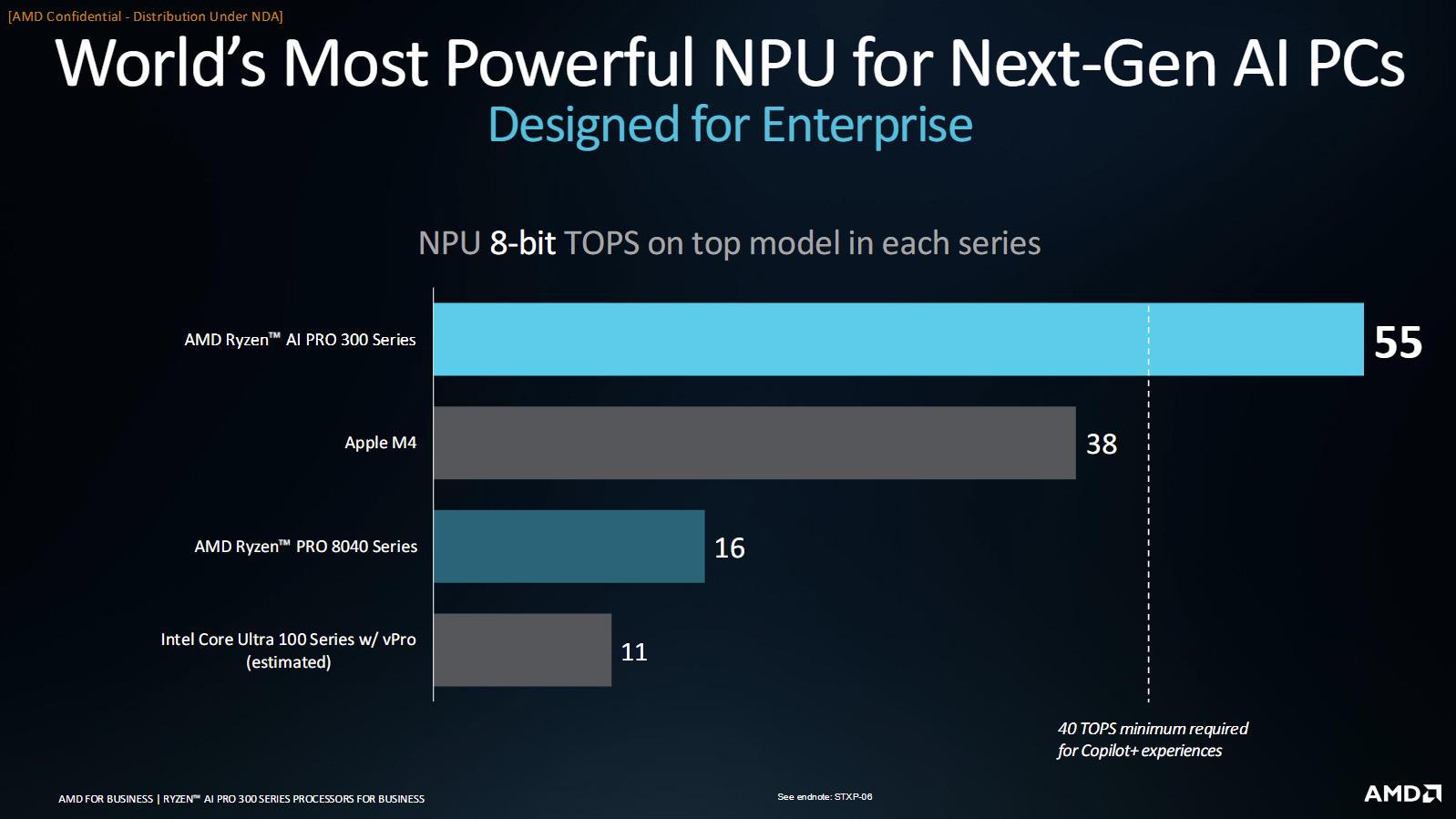What you need to know
- AMD expands its AI processor range with three Ryzen AI PRO variants for the enterprise market.
- Featuring an NPU running at up to 55 TOPS and Radeon 800M integrated graphics, all SKUs support local Copilot AI tasks.
- Ryzen AI PRO 300 chips are mostly compared against Intel Core Ultra 7 vPro devices, boasting a productivity performance lead.
AMD is once again leveling up its processor offerings in the enterprise market as it launches the Ryzen AI PRO 300 Series with, among the usual focus on enhanced security and data privacy, a return to hardware-enabled AI computing following its commercial Ryzen AI 300 processors compatible with Copilot+.
It isn’t AMD’s first adventure into AI PC technology either, already having launched the Ryzen PRO 7000 Series and PRO 8000 Series with integrated Neural Processing Units (NPUs) before that, gradually moving its total Tera Operations per Second (TOPS) capability up from a score of 10 TOPS to 50-55 TOPS.
| Header Cell – Column 0 | Cores/Threads | Max Clock | NPU | Graphics |
|---|---|---|---|---|
| 9 HX PRO 375 | 12/24 | 5.1 GHz | 55 TOPS | Radeon 890M |
| 9 HX PRO 370 | 12/24 | 5.1 GHz | 50 TOPS | Radeon 890M |
| 7 PRO 360 | 8/16 | 5.0 GHz | 50 TOPS | Radeon 880M |
Ryzen PRO remains an enterprise-centric platform powering laptops like HP’s new EliteBook X, but AMD still aims to provide top-tier performance and the kind of true all-day battery life I saw in devices running its Ryzen AI 300 chips, like in my ASUS Zenbook S 16 review.
Extra layers of security and simplified development environments for developers working with AI models on the traditional x86-64 platform come with the rest of the Ryzen PRO namesake, as AMD labels it “the world’s best processor for next-gen AI enterprise PCs.”
What’s new in Ryzen PRO for enterprise?
Ryzen AI PRO 300 benefits from the same upgrades as its non-PRO counterparts in that these Zen 5 CPUs feature alongside the latest versions of each chiplet inside AMD’s System on Chip (SoC.) Adopters will get access to its XDNA 2 NPU, which currently boasts the highest TOPS count in the market, now up from 50 to 55 TOPS and more than capable of running local AI computing tasks used by Microsoft Copilot, like Windows Recall.
Integrated RDNA 3.5 graphics also see a bump to AMD’s Radeon 800M Series with support for AI-powered graphical enhancements running with increased power efficiency than its previous-gen Radeon 700M solution. However, not everything relies solely on the NPU, and AMD is confident that the Ryzen PRO 300 CPU, GPU, and NPU combinations in each SKU will intelligently handle each AI task it can complete most efficiently.
Nevertheless, AMD has a clear lead on raw performance in the NPU category, which helps it introduce the “world’s first Copilot+ PCs designed for enterprise,” given the fulfillment (and beyond) of Copilot’s 40 TOPS requirement. Local AI computing hardware unlocks access to Live captions and real-time translation for obvious uses in a professional environment like video calls, but also more specific control over image generation with Cocreator.
Compared to its competitors, Intel’s latest Core Ultra 200V mobile processors, codenamed Lunar Lake, feature a 48 TOPS NPU, while the NPU in Qualcomm’s high-end Snapdragon X Elite maxes out at 45 TOPS. However, as AI computing advances and developers refine models to improve efficiency, the need to chase an ever-higher TOPS count might not prove as important. Still, if AMD isn’t compromising CPU and GPU performance to include the XDNA 2 tile, it couldn’t hurt.






